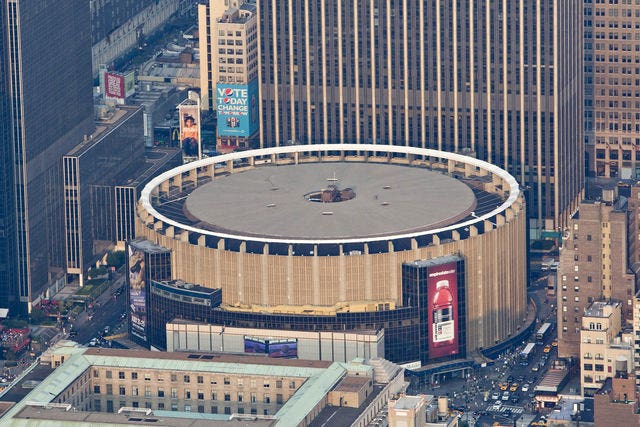
Clem Labine
To Transform Penn Station, Madison Square Garden Must Move!
For foodies, MSG means monosodium glutamate, which gives lots of people headaches. In our case, MSG means Madison Square Garden – which also gives Penn Station advocates severe headaches.
Madison Square Garden, which opened in 1968, sits in the space formerly occupied by the original Penn Station, Charles Follen Mckim’s Beaux-Arts masterpiece. To create the current MSG arena, developers merely lopped off the old Penn Station at sidewalk level and built above the train tracks and platforms, which still function as they have since 1910. But now all train passengers are crowded into a dismal maze of tunnels and passageways. Over 600,000 daily riders – more than any other transit hub in North America – are subjected to this dehumanizing treatment.
To great fanfare, New York Gov. Andrew Cuomo has announced a project to build a new station in the old Farley Post Office Building across Eighth Ave. from the current horror show. However, Cuomo’s project leaves MSG in place and is NOT a substitute for a new rebuilt Penn Station. Among the shortcomings of Cuomo’s Moynihan station program: (1) It serves only AMTRAK passenger plus about 15% of LIRR traffic – a total of 65,000 daily passengers; (2) Because Cuomo’s plan allows MSG to remain in place, it leaves about 535,000 daily LIRR and NJ Transit riders jostling in Penn Station’s grim underground passages; (3) Cuomo’s major nod to alleviating conditions in the old Penn Station tunnels is just to add LED lighting to the ceilings; (4) Cuomo’s $1.6 billion project cost will primarily benefit only 11% of Penn Stations daily users.
Madison Square Garden must move
Every serious study of Penn Station’s problems has concluded that MSG must move. Recognizing this, the New York Times teamed with architect Vishaan Chakrabarti to promote a plan to convert the existing MSG structure into a massive glass-enclosed train hall: The NY Times plan, while attractive in its simplicity and relative economy, has some significant limitations: (1) It is a little plan that lacks "the magic to stir men's blood." (2) It leaves the 2 Penn Plaza office tower in place – totally blocking view of the station from Seventh Ave. Presence of the office tower also sacrifices a rare opportunity to enhance the civic space and increase adjacent property values. (3) It does little to alleviate the plight of NJ Transit riders, nor does it deal with the need to accommodate increased passenger load from the new Gateway Tunnel project.
The REBUILD proposal that brings back McKim’s original Penn Station solves all of these problems. By twinning the REBUILD plan with Jim Venturi’s plan for making Penn Station through running, the region gets the greatest benefit at the lowest cost: (1) A rebuilt landmark will be a far bigger tourist magnet than yet another glass box; (2) It creates the potential for a magnificent civic precinct that would increase property values and tax revenues; (3) It alleviates many of the bottlenecks that currently plague LIRR and NJ Transit passengers; and (4) It allows for increased traffic from Gateway Tunnel without the vast expense of creating Penn Station South; (5) Rebuilding McKim’s low-rise Penn Station will bring light and air to a section of Manhattan that needs it desperately.
To achieve the greatest public good, Madison Square Garden must move. Of course, conducting the negotiations to make that happen will require that rarest of all commodities: Political will.
Clem Labine is the founder of Old-House Journal, Clem Labine’s Traditional Building, and Clem Labine’s Period Homes. His interest in preservation stemmed from his purchase and restoration of an 1883 brownstone in the Park Slope section of Brooklyn, NY.
Labine has received numerous awards, including awards from The Preservation League of New York State, the Arthur Ross Award from Classical America and The Harley J. McKee Award from the Association for Preservation Technology (APT). He has also received awards from such organizations as The National Trust for Historic Preservation, The Victorian Society, New York State Historic Preservation Office, The Brooklyn Brownstone Conference, The Municipal Art Society, and the Historic House Association. He was a founding board member of the Institute of Classical Architecture and served in an active capacity on the board until 2005, when he moved to board emeritus status. A chemical engineer from Yale, Labine held a variety of editorial and marketing positions at McGraw-Hill before leaving in 1972 to pursue his interest in preservation.








